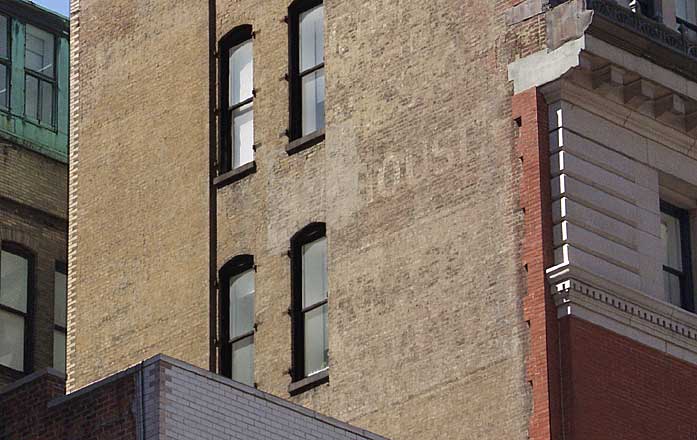
Knabe Pianos, 148-152 5th Ave., SW corner of 20th St. (2004)

Below the word "House" appears a sign for Knabe Pianos. This was a showroom for the firm founded by William Knabe (1803-1864). Baker's Biographical Dictionary of Musicians (2001) describes Knabe as "Knabe, Valentine Wilhelm Ludwig, German-born American manufacturer; b. Kreuzberg, near Oppeln, Prussia, June 3, 1803; d. Baltimore, May 21, 1864. He settled in the U. S. in 1833. He formed a partnership to manufacture pianos with Henry Gaehle in Baltimore in 1839, which continued until the latter's death in 1855. The business was continued by Knabe's sons and grandsons until it was merged with the American Piano Co. in 1908. It became a part of the Aelian American Corp. in 1932."
The following account of William Knabe is given in Pianos and Their Makers, by Alfred Dolge (1911), "Born in Kreutzberg, Germany, in 1803, he received a superior education, intending to follow a learned profession. When the time for ultimate decision came, William preferred, however, to learn the art of piano making. He served the customary apprenticeship and acquired further experience while working for various masters in Germany. Coming to Baltimore in 1833, he found engagement with Henry Hartje, who had won quite a reputation as an inventor. Conservative and careful, Knabe waited until he had mastered the English language and had become thoroughly familiar with the business conditions of the new country. It was, therefore, not until 1839, that he ventured in business, associating himself with another German piano maker, Henry Gaehle, under the firm name of Knabe & Gaehle. The enterprise was moderately successful and the association continued until 1854, when Gaehle withdrew. From that time on Knabe was able to demonstrate his exceptional ability as a piano maker and business man without hindrance. His pianos were second to none in the market, and he handled the commercial end of his business so cleverly that by 1860 his firm almost controlled the entire market of the southern States. The Civil War temporarily destroyed that market, and the firm of William Knabe & Company went through a trying period for over five years. Wearied from over-anxiety, care and worry, Knabe passed away in 1864, leaving the care of the great business, which he had founded and built up to magnificent proportions, to his sons, William and Ernest..."
William Knabe & Co. piano fortes had its first New York location at 112 5th Ave. (near 17th St.). This ad from 1885 shows their Baltimore address and the New York address at 112 5th Ave. They moved to 148-152 5th Ave. in 1890. The building has a pediment with the letters MBC standing for Methodist Book Concern. Designed by Edward Hall Kendall (1842-1901), the MBC (1888-90) contained offices for the Methodist Episcopal Church, the Missionary Society, a printing house, a daily service chapel, a library and reception rooms. The Knabe showrooms on the ground floor were rented space. Click here for image from New York Times, 20-Oct-1897, p. 2.
Around 1899 Knabe moved across 20th St. into the Presbyterian Building (1894-1895, James B. Baker, arch.) at 154-158 5th Ave. on the northwest corner of 5th Ave. and 20th St. They remained at this location until 1907 when they moved up 5th Ave. again to the southeast corner of 39th St. (437-439 5th Ave.). This ad for space at the new Knabe Building appeared in the New York Times, 14 April 1907. The building at 39th St. can be seen in an excellent view by the Wurts Brothers (undated but probably 1930s) on the New York Public Library's Digital Collections. This move was followed in 1927 with removal to their second Knabe Building at 657 5th Ave. on the northeast corner of 52nd St. Click here for image from New York Times, 14-Apr-1927, p. 5. AMPICO at the top of this ad stands for American Piano Company (with whom Knabe merged in 1908).This sign dates between 1890 and 1899.
< previous || next > index map signs by date signs by name see what's new